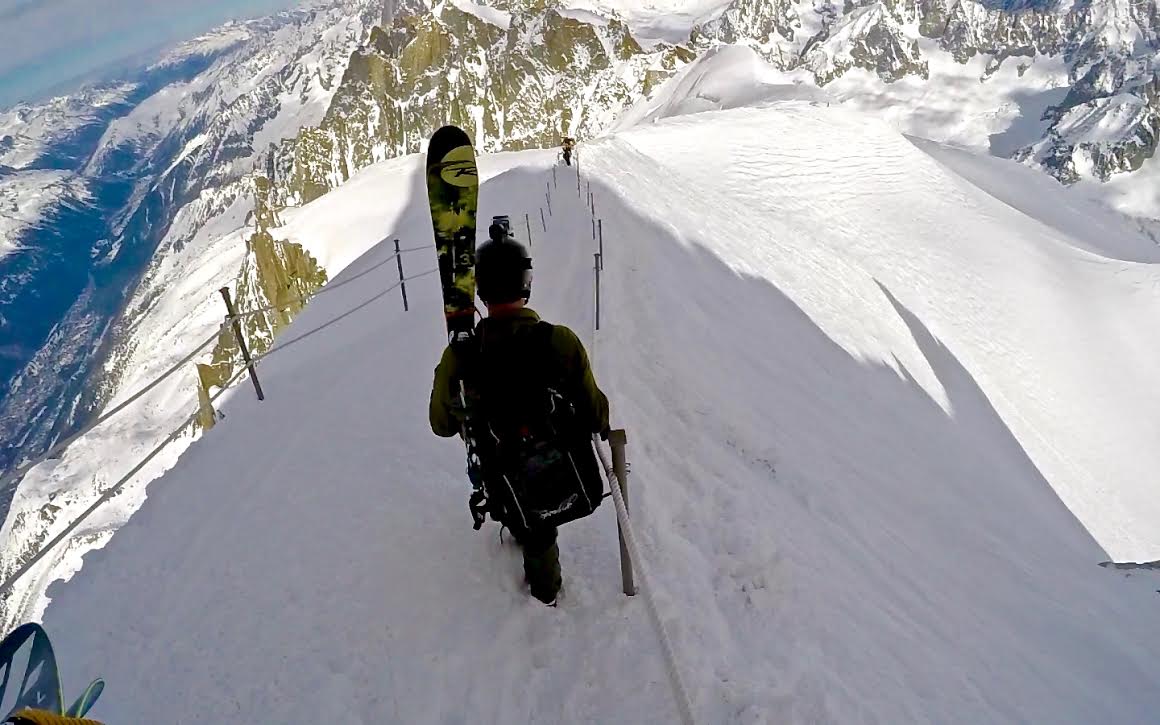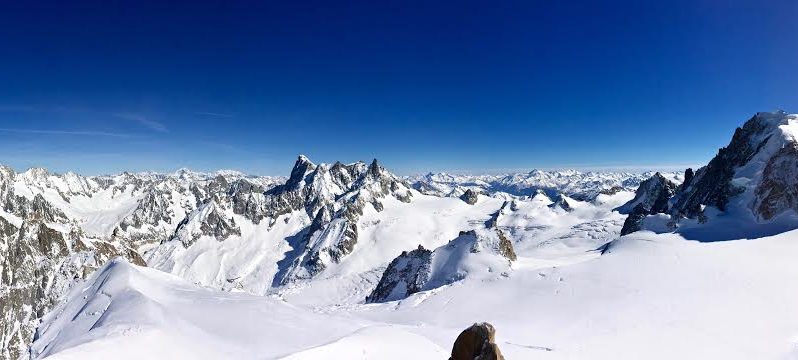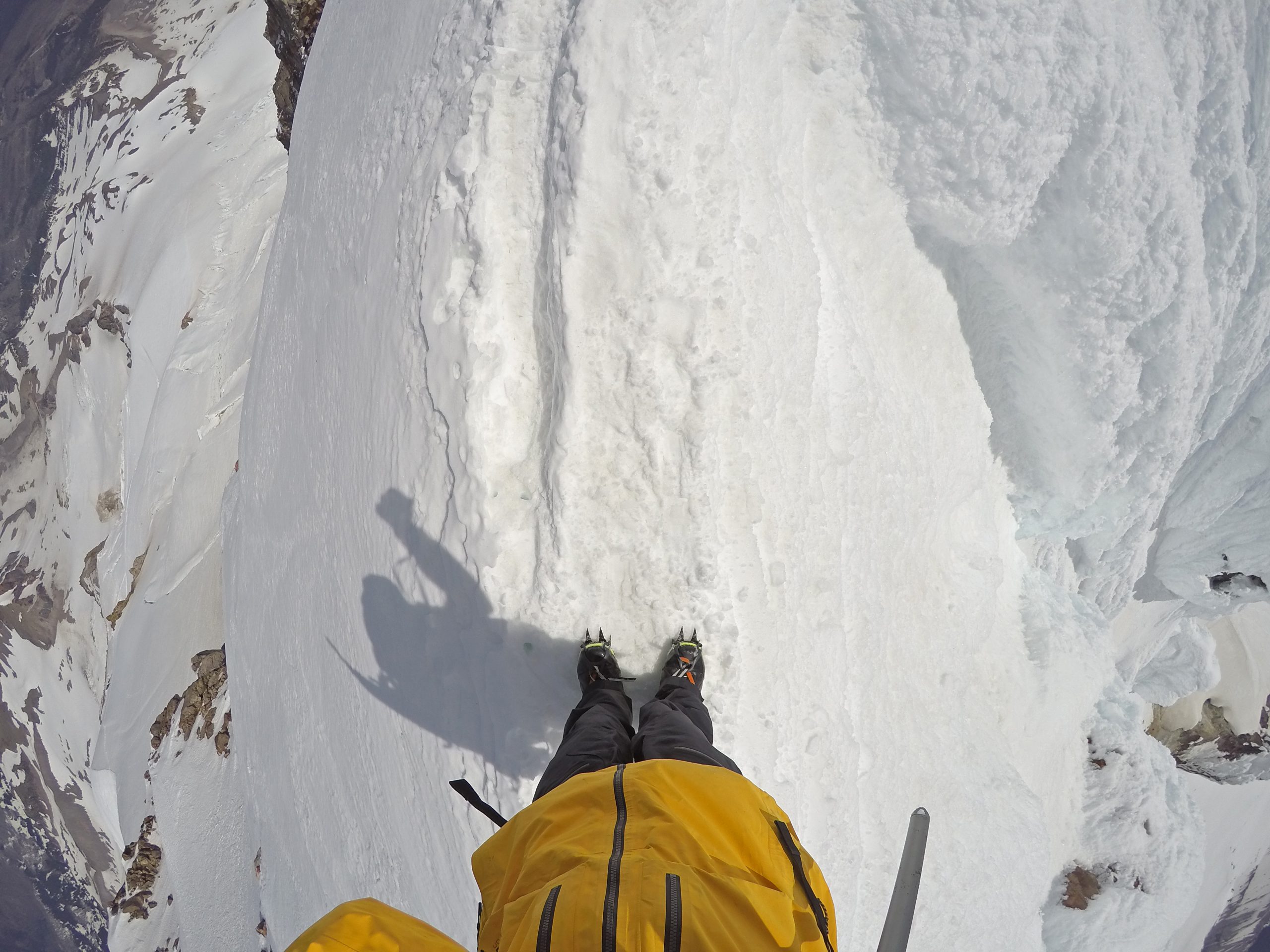Editor’s Note: You won’t catch me speed-flying any time soon. But I can certainly see the allure of climbing to the top of a huge mountain, jumping off the top, and flying down into the valley with a pair of skis underfoot just in case you see some fresh snow to hit. That’s what Zach Carbo does, on Mt. Hood, in Alaska, and as of last spring, in the Alps. I sat down with Zach the other day to learn more about his trip to Chamonix, where you can ride a gondola up to 12 and a half thousand feet and fly the high country all day long. I asked Zach to tell me about one of his best flights, and he insisted on two:
The day before we went to Italy, we went to Aiguille du Midi. We were up at 12,600 feet, so you could feel that altitude a little bit. It was a pretty clear day for the most part, you could see the summit of Mont Blanc. You look down one side and see this massive mountain that goes down to a glacier, and you look down another side and you see the Vallee Blanche run, the Mer de Glace that goes down the other side. You look across and you see Italy.
I was with my good friend Troy Keys, who has been in the skydiving world for 20 years, paragliding for well over a decade, speed flying since just about when it began. He lives out in Utah.
So you’re up there, and it’s a lot to take in. Also, it’s kind of the end of the day. The air was starting to go what they call catabolic, which is what happens when cold air starts to fall down the mountain. When that happens, flying isn’t good. Basically, it’s pushing you down.
So we were moving. There is an ice stairway that has little ropes on each side, and you would think that these metal posts coming out of the ice are probably bolted into the rock. They’re not. So you slip a little bit and you kind of hold onto the rope, and you see these poles sliding up and down. And you realize, okay, in no way, shape or form am I firmly anchored. I’ve got touring boots on, so they have grip, but you’re on ice. I expended so much energy and I was so tense. Because I don’t like heights. One side is 40 or 50 degrees down to a glacier and the other side is the north face and it’s sheer, thousands of feet down. So I was just white-knuckling it the entire time.
You go down along a little switchback and then the gates open, and that’s it. Bad on us, we just wanted to click in and ski and lighten the load, so we didn’t bring crampons. Probably should have. We were on the ridge and it was smoothed over. If you slip, that’s it. Done.

We had a couple hundred feet to go to reach the launch area. And I am peaking, just so acute, so tense, trying to loosen up, trying to breathe. I don’t like exposure when I’m in the mountains. I just can’t stop thinking, one slip and I’m done. So I really feel self-conscious about that. But then I reached the others on a flatter area and we were high-fiving and everything, and I look over at Troy and he’s like, ‘I was not okay with that.’ And I was thinking, okay, I’m not the only one.
So we lay out our wings, and the wind was super-calm but you could feel the conditions changing. It was just about to get catabolic. And when the air is catabolic, it’s basically going with you down the mountain. So your wing does not want to come up and pressurize. So if you get to a certain point, once it rolls over, that’s it. That wing isn’t going up over the wind, you’re done. You’re going to have about 3 or 400 feet to think about it.
Our friends from Colorado were going down the south face, and we were going down the north face. It’s about 7,000 feet down, and we have to catch the last gondola down from there, or else we’re skiing and hiking. So Troy goes, and I go behind him, and it was just sensory overload. My gear is made out of the same material that paragliders are made out of, but it’s designed to fly as steep and close to the terrain as possible, like a swallow. You see these seracs that are hundreds of feet thick, these big crevasses that you’re flying over. And then there are the cables for the gondola. And we need to land at a certain place at the bottom of this avalanche serac debris field, which has huge crevasses in it. So you’re constantly thinking, I need to land there, I want to fly near all this stuff but I also want to avoid it, and plus I have my friend flying here. We can’t collide. There’s just so much going on.
We fly all the way to the bottom, and Troy ends up going a little steeper and deeper than I do and lands earlier, and I fly on and make it all the way to the mid-station. We link up, we high-five, we catch the second-to-last gondola back, and we start making plans to go to Italy the next day.
The Italy run is very similar, but because it’s south-facing it’s in the sun most of the day, so you have to watch the snow conditions. But it’s 7400-plus feet and you can just do it all day long. There’s a knob in the mountain that splits the glacier into two, so you can go to one side or the other. You could fly there for two weeks and never fly the same line twice. Again, sensory overload. It was mind-blowing.
{igallery id=6615|cid=76|pid=2|type=category|children=0|addlinks=0|tags=|limit=0}
Zach Carbo has completed over 1,200 civilian and military freefall parachute jumps and 400 B.A.S.E. jumps. He lives with his family in Tacoma, Washington. You can check out his blog, Living the High Life, here.
Last modified: June 10, 2016




